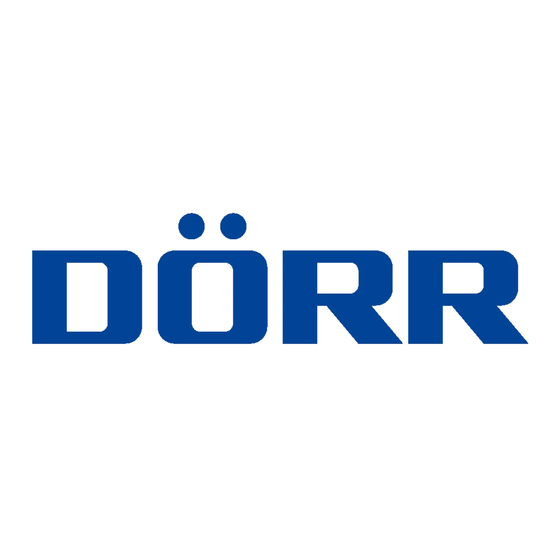
Inhaltszusammenfassung für Dorr DANUBIA ATLAS 2000
- Seite 1 ATLAS 2000/ORION 200 SIRIUS 150 EQ3-2 & EQ5 MONTIERUNG BEDIENUNGSANLEITUNG INSTRUCTION MANUAL NOTICE D’UTILISATION MANUAL DE INSTRUCCIONES MANUALE D'ISTRUZIONI doerrfoto.de...
-
Seite 2: Inhaltsverzeichnis
01 | SICHERHEITSHINWEISE Schauen Sie durch dieses Teleskop oder durch den Sucher NIEMALS direkt • in die Sonne oder in die Nähe der Sonne! Es besteht Erblindungsgefahr! Das Teleskop ist kein Spielzeug! Kinder dürfen das Teleskop nicht ohne VIELEN DANK, dass Sie sich für ein Qualitätsprodukt aus dem Hause •... -
Seite 3: Eq3-2-Montierung
ATLAS 2000/SIRIUS 150 03 | TEILEBESCHREIBUNG EQ3-2 EQ3-2-MONTIERUNG ATLAS 2000/SIRIUS 150 Staubkappe (vor Beobachtung entfernen) Okularauszug Sucher Sucher-Halterung Sucher-Einstellschrauben Okular Fokussierschraube Piggyback-Klemme Teleskop-Hauptrohr Hauptspiegelposition Flexible Welle DEC. R.A. Klemmschraube Polarscope Halterung (nicht sichtbar) Polhöhen-Stellschraube Gegengewichtsstange Gegengewicht Gegengewicht-Fixierschraube Azimuth-Einstell-Schraube DEC. Klemmschraube Rohrschellen Stativbeine Zubehörablageschale... -
Seite 4: Montageanleitungatlas 2000/Sirius 150 Mit Eq3-2-Montierung
05 | MONTAGEANLEITUNGATLAS 2000/SIRIUS 150 MIT EQ3-2-MONTIERUNG 05.1 AUFSTELLEN DES STATIVS Anpassen der Stativ-Beine (Fig.1) Öffnen Sie die Stativbeinklemmen und ziehen Sie das untere Stativrohr an jedem Stativbein heraus. • Fixieren Sie dann wieder die Stativbeinklemmen. Ziehen Sie die Stativbeine auseinander, damit das Stativ gerade stehen kann. •... -
Seite 5: Montageanleitung Orion 200 Mit Eq5 Montierung
06 | MONTAGEANLEITUNG ORION 200 MIT EQ5-MONTIERUNG 06.1 AUFSTELLEN DES STATIVS Anpassen der Stativ-Beine (Fig.16) Öffnen Sie die Stativbeinklemmen und ziehen Sie das untere Stativrohr an jedem Stativbein heraus. • Fixieren Sie dann wieder die Stativbeinklemmen. Ziehen Sie die Stativbeine auseinander, damit das Stativ gerade stehen kann. •... -
Seite 6: Okulare Einsetzen
06.4 OKULARE EINSETZEN Einsetzen der Okulare (Fig.29, 30) Lösen Sie die Rändelschraube am Ende des Okularauszuges und entfernen Sie die schwarze Schutzkappe. • Stecken Sie das gewünschte Okular in den Okularauszug und fixieren Sie das Okular mit den Rändel- • schrauben. -
Seite 7: Die Nivellier-Libelle Verwenden
Ausbalancieren in DEC. Vor dem Ausbalancieren um die DEC Achse sollte das Teleskop um die R.A. Achse ausbalanciert sein und alle gewünschten Zubehörteile sollen am Teleskop angebracht sein. Die genaueste Ausrichtung erzielen Sie, wenn Sie das Teleskop auf 60° bis 75° Breite einstellen. •... -
Seite 8: Fokussieren
07.8 FOKUSSIEREN Fig.h Drehen Sie langsam am Fokussierknopf bis Sie im Okular ein scharfes Bild erhalten (Fig.h). Wegen Tempera- turänderungen, etc. muss das Bild normalerweise nach einiger Zeit leicht nachfokussiert werden. Dies ist oft bei kurzbrennweitigen Teleskopen notwendig – vor allem, wenn sie noch nicht die Aussentemperatur erreicht haben. -
Seite 9: Verwendung Der Teilkreise
07.11 VERWENDUNG DER TEILKREISE Fig.j Am einfachsten findet man Objekte indem man die Sternbilder auswendig lernt und den Sucher bzw. Red Dot Klemmschraube Finder verwendet. Zum Auffinden lichtschwacher Objekte können Sie aber auch die Teilkreise Ihrer Mon- Zeiger tierung benutzen. Mit Hilfe der Teilkreise können Sie Objekte über ihre Himmelskordinaten lokalisieren, die Sie in einer Sternenkarte, o.ä. -
Seite 10: Suchen Von Himmelsobjekten
Lösen Sie die R.A. Klemmschraube und schwenken Sie die Montierung um die R.A. Achse bis der "1. No- Fig.k2 vember" (die lange Linie zwischen 10 und 11) auf dem Datumsring mit "0" (Mitternacht) auf der R.A. Teilkreis Klemmschraube übereinstimmt und fixieren Sie die R.A. Klemmschraube (Fig.k2). Lockern Sie nun die drei Einstellschrauben Zeiger des Polarscopes. -
Seite 11: Wahl Des Passenden Okulars
Das Teleskop zeigt zum westlichen oder östlichen Horizont Himmelspol Fig.o (NCP) Nun soll das Teleskop auf einen Punkt am westlichen (Fig.o1) oder östlichen (Fig.o2) Horizont zeigen. Wenn das Gegengewicht nach Norden zeigt, kann das Teleskop durch Drehen um die DEC. Achse vom westlichen zum östlichen Horizont geschwenkt werden, wobei es auf seinem DEC.-Bogen den NCP passiert (jeder DEC.- Bogen geht durch den NCP). -
Seite 12: Berechnung Der Gesichtsfeldes
10.2 BERECHNUNG DER GESICHTSFELDES Als Gesichtsfeld bezeichnet man den Bereich des Himmels, den Sie durch Ihr Teleskop sehen. Die Größe des Gesichtsfeldes wird als tatsächliches oder wahres Gesichtsfeld bezeichnet und hängt vom verwende- ten Okular ab. Bei jedem Okular gibt der Hersteller das scheinbare Gesichtsfeld des Okulars in Grad an. Um das wahre Gesichtsfeld zu bestimmen, muss man das scheinbare Gesichtsfeld des Okularsdurch die damit erzielte Vergrößerung dividieren. -
Seite 13: Wahl Der Beobachtungszeit
11.3 WAHL DER BEOBACHTUNGSZEIT Zum Beobachten brauchen Sie eine ruhige Luft und natürlich eine klaren Blick zum Himmel. Es ist nicht not- wendig, dass der Himmel wolkenlos ist. Bei leicht bewölktem Himmel hat man oft exzellentes "Seeing". Be- obachten Sie nicht unmittelbar nach Sonnenuntergang, da das Auskühlen der Erde zu Turbulenzen führt. In Laufe der Nacht wird nicht nur das "Seeing"... -
Seite 14: Justieren Des Hauptspiegels
12.3 JUSTIEREN DES HAUPTSPIEGELS Stellschraube Fixierschraube Fixierschraube Stellschraube Suchen Sie die 3 Fixierschrauben am unteren Tubusende und lösen Sie sie ein paar Umdrehungen. • Wenn Sie 3 große Rändelschrauben aus dem Teleskop hervorstehen sehen und 3 Kreuzschlitzschrauben • neben ihnen, dann sind die Kreuzschlitzschrauben die Fixierschrauben und die Rändelschrauben die Stell- schrauben. - Seite 67 DÖRR GmbH Messerschmittstr. 1 D-89231 Neu-Ulm Fon: +49 731 97037-0 Fax: +49 731 97037-37 info@doerrfoto.de doerrfoto.de doerrfoto.de...


